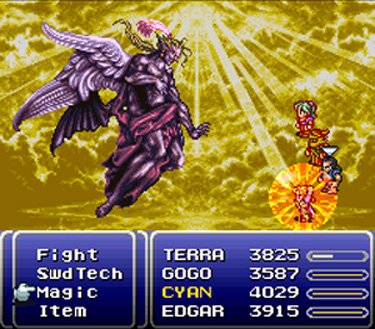That's right, they made the boss bigger in a cheap attempt to intimidate the player. If this isn't the game mechanic version of a Deus Ex Machina, I don't know what is. Think about it. Throughout the game, you've accumulated vast amounts of power, even more than what you've seen from the main villain. So what is the developer to do in order to make the boss challenging? "I know, let's inexplicably make them 10 times bigger and more powerful! Oh, and while we're at it, make them look NOTHING like the main villain we've seen all game."
The concept of the Final Form Boss, as I will refer to it, can be traced back to the SNES days. Back then, while it was normal to have all character sprites be of the same size, enemy sprites would often be bigger, especially in JRPGs. Enemies in such games were more likely to be unanimated but highly detailed paintings. Of course, final bosses couldn't be the same size as the player in combat, even if we'd seen them at that size for the entire game, and thus their in-battle designs would show only modicum of similarity to their more common form.
As technology has improved, however, the Final Form Bosses have not gone away. In fact, they remain as prevalent as ever, and I must ask... why? Is it so much to ask that we pick on someone our own size?
Things are starting to get a little bit better, though. Batman: Arkham City has a fight against a regular-sized Joker. The bosses in Deus Ex: Human Revolution are proportionate to Adam Jensen. The Assassin's Creed series hasn't jumped the shark quite enough to throw a 6-story Templar your way. There is some hope in this area, but not a lot. No matter what, though, bosses still have one major problem: patterns.
Developers still feel the need to give bosses attack patterns so they can be more easily defeated. When this is against a Final Form Boss, you feel empowered, like you've accomplished something. When you do this against a boss who is around your height, weight, and polycount, you feel... ripped off, like you were almost expecting another player to be controlling that boss; someone who can think like a human instead of a gigantic machine.
It is a strange discrepancy. We can forgive Final Form Bosses for being big and dumb because they're too big to be anything other than pattern-based. Get a boss around our size, however, and they still act big and dumb because the programmers only have so much time on their hands. What's a designer to do?
Well, for one, size can indeed equal intimidation, but if you want a big final boss then give us a big enemy to begin with. Making them suddenly go "I'M BIG NOW!" is a lame device meant to scare away lesser players and, let's face it, it's 2012. We're all smarter than that now.
Yet video games will always have the stigma of the Final Form Boss attached to them. We expect the biggest monster of them all to come at us at the end of the game, to test our mettle, and use every last bullet we've got to take them down (or some cheap, introduced-at-the-last-second uber weapon that is only used to defeat them). To that, I say nay. Though I do wish to test my mettle, I do not wish to do so at the cost of fighting a form of the main antagonist I wasn't promised. Monster Mega Smith? Please. Mecha Hitler? For fuck's sake. Let me fight with whom I was promised a fight or I want my $60 back.



No comments:
Post a Comment